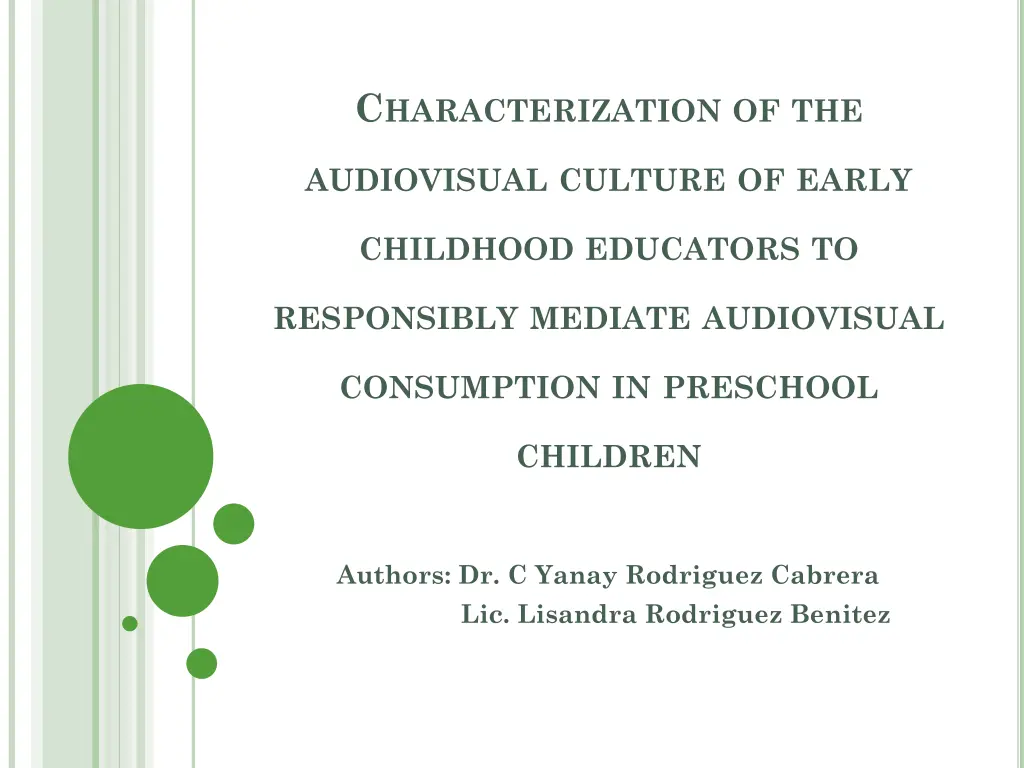
Responsible Mediation of Audiovisual Consumption in Preschool Children
Explore the characterization and importance of audiovisual culture in early childhood education to promote responsible media consumption in preschoolers. The research delves into the synergy of knowledge, skills, and values necessary for educators to maximize the developmental potential of audiovisual materials. Various research methods are employed to enhance understanding and application in educational settings.
Download Presentation

Please find below an Image/Link to download the presentation.
The content on the website is provided AS IS for your information and personal use only. It may not be sold, licensed, or shared on other websites without obtaining consent from the author. If you encounter any issues during the download, it is possible that the publisher has removed the file from their server.
You are allowed to download the files provided on this website for personal or commercial use, subject to the condition that they are used lawfully. All files are the property of their respective owners.
The content on the website is provided AS IS for your information and personal use only. It may not be sold, licensed, or shared on other websites without obtaining consent from the author.
E N D
Presentation Transcript
CHARACTERIZATION OF THE AUDIOVISUAL CULTURE OF EARLY CHILDHOOD EDUCATORS TO RESPONSIBLY MEDIATE AUDIOVISUAL CONSUMPTION IN PRESCHOOL CHILDREN Authors: Dr. C Yanay Rodriguez Cabrera Lic. Lisandra Rodriguez Benitez
It is not enough for society to have access to increasingly sophisticated technological objects if it does not convert them into means for individual and social development. National Literacy Trust UNICEF Use of audiovisual materials that correspond to the characteristics of the children and their development needs Prix Jeunesse Foundation Kaiser Family Foundation
Not everything that surrounds the child is a source for his psychic development, but only what he interacts with, what he assimilates under the direction of the adult (Elkonin, 1983). The Convention on the Rights of the Child (1989) The 2030 Agenda for Sustainable Development III Improvement of the Cuban Educational System Constitution of the Republic of Cuba (2019) Research Projects Rios y Noa (2016-2018) Rios (2021-2023) Alvarez (2018) Sandoval (2018) Rivera (2021) Researchs Noa (2015), Rodriguez (2015), Batista (2017) y Morejon (2019) Adult mediation to turn audiovisual materials into development media
Audiovisual culture that early childhood educators need Insufficient actions, from university vocational training, to develop it Characterize the audiovisual culture of early childhood educators to responsibly mediate audiovisual consumption in preschool children.
RESEARCH METHODS Document analysis Analytical - synthetic Survey Inductive - deductive Interview System approach Observation MATHEMATICS - STATISTICS Percentage analysis Descriptive statistics
Audiovisual culture of early childhood educators Synergy of knowledge, skills and values that makes it possible to take advantage of the educational potential of audiovisual materials and media to achieve the maximum possible comprehensive development of each boy and girl in the early childhood educational process. Rodriguez y Vazquez (2021) 4
AUDIOVISUAL CULTURE OF EARLY CHILDHOOD EDUCATORS Phases and moments for the use of audiovisual materials Concept of early childhood education and development Audiovisual language and quality criteria for early childhood Moments Previous preparation Joint viewing Post-vision Image Sound Textual structure Characters Identity Diversity Potential for development Phases 1. Selection 2. Design/development 3. Use and support 4. Evaluation
Gnoseological Pedagogically and psychologically bases audiovisual materials as a means of development Instrumental Select audiovisual materials relevant Evaluative Makes value judgments about the relevance of audiovisual materials Explains the mediating role of educators Deploy the actions of each moment Argues the use of nationally produced audiovisual materials Describes the hygienic and ergonomic conditions Deploy the actions of each phase Criticize audiovisual materials with responsibility and professional ethics Identify elements of audiovisual language that constitute quality criteria Evaluates the effectiveness of the audiovisual material based on the intended objective
Instruments Population Sample Survey Interview Observation 462 first-year students 37 first-year students 15 professors of the course 10 professors of the course Survey
DECISION RULE An lisis cuantitativo BROAD Development: Values between 2.34 - 3 Index of each Dimension MEDIUM Development: Values between 1.67 - 2.33 3.01 BASIC Development: Values between 1 - 1.66 2.34 1.52 1.51 1.67 1.29 1 Variable Index Gnoseological Dimension Instrumental Dimension Evaluative Dimension 3.01 2.34 1.44 1.67 1.00
STRENGTHS WEAKNESSES They recognize the playful nature and educational potential of audiovisual materials. They do not identify pedagogical and psychological foundations that justify its use as a means of development. They are identified as mediators responsible for the audiovisual materials consumed by the child. They limit the mediating role to the development of the teaching- methodological function in the institutional modality. The audiovisual materials to be used with early childhood are selected. These actions are not promoted in families nor are best practices investigated. They defend the use of nationally produced audiovisual materials. The selection criteria that prevail are the children's preferences and the theme to work on for the day.
Conclusions The basic development of the audiovisual culture of educators professional training possibility of responsibly mediating the audiovisual consumption carried out by the children with whom they work. in university undermines the The results of the research lead to the development of a pedagogical strategy from university professional training for the development culture of early childhood educators. of the audiovisual
